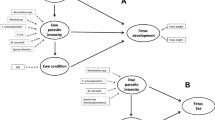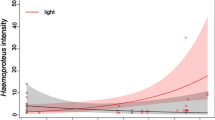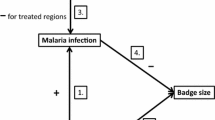Abstract
Carry-over effects take place when events occurring in one season influence individual performance in a subsequent season. Blood parasites (e.g. Plasmodium and Haemoproteus) have strong negative effects on the body condition of their hosts and could slow the rate of feather growth on the wintering grounds. In turn, these winter moult costs could reduce reproductive success in the following breeding season. In house martins Delichon urbica captured and studied at a breeding site in Europe, we used ptilochronology to measure growth rate of tail feathers moulted on the winter range in Africa, and assessed infection status of blood parasites transmitted on the wintering grounds. We found a negative association between haemosporidian parasite infection status and inferred growth rate of tail feathers. A low feather growth rate and blood parasite infections were related to a delay in laying date in their European breeding quarters. In addition, clutch size and the number of fledglings were negatively related to a delayed laying date and blood parasite infection. These results stress the importance of blood parasites and feather growth rate as potentially mechanisms driving carry-over effects to explain fitness differences in wild populations of migratory birds.



Similar content being viewed by others
References
Abramoff MD, Magelhaes PJ, Ram SJ (2004) Image processing with image. J Biophotonics Int 11:36–42
Allander K, Sundberg J (1997) Temporal variation and reliability of blood parasite levels in captive yellowhammer males Emberiza citrinella. J Avian Biol 28:325–330
Amat JA, Aguilera E, Visser GH (2007) Energetic and developmental costs of mounting an immune response in greenfinches (Carduelis chloris). Ecol Res 22:282–287
Arnold JM, Hatch JJ, Nisbet ICT (2004) Seasonal declines in reproductive success of the common tern Sterna hirundo: timing or parental quality? J Avian Biol 35:33–45
Balbontín J, Hermosell IG, Marzal A, Reviriego M, de Lope F, Møller AP (2007) Age-related change in breeding performance in early life is associated with an increase in competence in the migratory barn swallow (Hirundo rustica). J Anim Ecol 76:915–925
Balbontín J, Møller AP, Hermosell IG, Marzal A, Reviriego M, de Lope F (2009) Divergent patterns of impact of environmental conditions on life history traits in two populations of a long-distance migratory bird. Oecologia 159:859–872
Bensch S, Grahn M (1993) A new method for estimating individual speed of moult. Condor 95:305–315
Bensch S, Stjernman M, Hasselquist D, Östman Ö, Hansson B, Westerdahl H, Pinheiro RT (2000) Host specificity in avian blood parasites: A study of Plasmodium and Haemoproteus mitochondrial DNA amplified from birds. Proc R Soc Lond B 267:1583–1589
Bergman G (1982) Why are the wings of Larus f. fuscus so dark? Ornis Fenn 59:77–83
Borras A, Cabrera T, Cabrera J, Senar JC (2004) Inter-locality variation in speed of moult in the citril finch Serinus citrinella. Ibis 146:14–17
Brodin A (1993) Radio-ptilochronology tracing radioactively labelled food in feathers. Ornis Scand 24:167–173
Brown CR, Brown MB (1999) Fitness components associated with laying date in the cliff swallow. Condor 101:230–245
Bryant DM (1975) Breeding biology of the house martin, Delichon urbica in relation to aerial insect abundance. Ibis 117:180–221
Burtt EH Jr, Ichida JM (1999) Occurrence of feather-degrading bacilli in the plumage of birds. Auk 116:364–372
Butler M, Johnson AS (2004) Are melanized feather barbs stronger? J Exp Biol 207:285–293
Cézilly F, Boy V, Green RE, Hirons GH, Johnson AR (1995) Interannual variation in greater flamingo breeding success in relation to water levels. Ecology 76:20–26
Christe P, de Lope F, González G, Saino N, Møller AP (2001) The influence of environmental conditions on immune responses, morphology and recapture probability of nestling house martins (Delichon urbica). Oecologia 126:333–338
Christe P, Møller AP, González G, de Lope F (2002) Intraseasonal variation in immune defence, body mass and hematocrit in adult house martin Delichon urbica. J Avian Biol 33:321–325
Cramp S (1988) The birds of the western palearctic, vol 5. Oxford University Press, Oxford
Dawson A, Hinsley SA, Ferns PN, Bonser RHC, Eccleston L (2000) Rate of moult affects feather quality: a mechanism linking current reproductive effort to future survival. Proc R Soc Lond B 267:2093–2098
De la Hera I, Díaz JA, Pérez-Tris J, Tellería JL (2009a) A comparative study of migratory behaviour and body mass as determinants of moult duration in passerines. J Avian Biol 40:461–465
De la Hera I, Pérez-Tris J, Tellería JL (2009b) Migratory behaviour affects the trade-off between feather growth rate and feather quality in a passerine bird. Biol J Linn Soc 97:98–105
Forbes S (2010) Family structure and variation in reproductive success in blackbirds. Behav Ecol Sociobiol 64:475–483
Gauthreaux JSA (1982) The ecology and evolution of avian migration systems. In: Farner DS, King JR, Parker KC (eds) Avian biology. Academic, New York, pp 93–163
Ginn HB, Melville DS (1983) Moult in birds (BTO Guide 19). British Trust for Ornithology, Hertfordshire
Greenberg R, Marra PP (2005) Birds of two worlds; the ecology and evolution of migration. Johns Hopkins University Press, Portland
Grubbr TC Jr (2006) Ptilochronology: feather time and the biology of birds. Oxford University Press, New York
Hansson B, Bensch S, Hasselquist D (2000) The quality and the timing hypotheses evaluated using data on great reed warblers. Oikos 90:575–581
Harrison XA, Blount JD, Inger R, Norris DR, Bearhop S (2011) Carry-over effects as drivers of fitness differences in animals. J Anim Ecol 80:4–18
Hurlbert SH (1984) Pseudo-replication and the design of ecological field experiments. Ecol Monogr 54:187–211
Jenni L, Winkler R (1994) Moult and ageing of european passerines. Academic, London
Klaassen M (1995) Moult and basal metabolic costs in males of two subspecies of stonechats: the European Saxicola torquata rubicula and the east African S. t. axillaris. Oecologia 104:424–432
Klasing KC (2004) The cost of immunity. Acta Zool Sin 50:961–969
Lack D (1968) Ecological adaptations for breeding in birds. Methuen, London
Langston NE, Hillgarth N (1995) The extent of primary molt varies with parasites in laysan albatrosses: a possible role in life history tradeoffs between current and future reproduction. Proc R Soc Lond B 261: 239–243
Lin LI-K (2000) A note on the concordance correlation coefficient. Biometrics 56:324–325
Lind J (2001) Escape flight in moulting tree sparrows (Passer montanus). Funct Ecol 15:29–35
Marra PP, Hobson KA, Holmes RT (1998) Linking winter and summer events in a migratory bird by using stable-carbon isotopes. Science 282:1884–1886
Martin RE, Kirk K (2007) Transport of the essential nutrient isoleucine in human erythrocytes infected with the malaria parasite Plasmodium falciparum. Blood 109:2217–2224
Martin LB II, Scheuerlein A, Wikelski M (2003) Immune activity elevates energy expenditure of house sparrows: a link between direct and indirect costs? Proc R Soc Lond B 270:153–158
Marzal A, de Lope F, Navarro C, Møller AP (2005) Malarial parasites decrease reproductive success: an experimental study in a passerine bird. Oecologia 142:541–545
Marzal A, Reviriego M, de Lope F, Møller AP (2007) Fitness costs of an immune response in the house martin (Delichon urbica). Behav Ecol Sociobiol 61:1573–1580
Marzal A, Bensch S, Reviriego M, Balbontin J, de Lope F (2008) Effects of malaria double infection in birds: one plus one is not two. J Evol Biol 21:979–987
Merino S, Moreno J, Sanz JJ, Arriero E (2000) Are avian blood parasites pathogenic in the wild? A medication experiment in blue tits (Parus caeruleus). Proc R Soc Lond B 267:2507–2510
Michener H, Michener JR (1938) Bars in flight feathers. Condor 40:149–160
Møller AP, de Lope F, Saino N (2004) Parasitism, immunity, and arrival date in a migratory bird, the barn swallow. Ecology 85:206–219
Møller AP, Nuttall R, Piper SE, Szép T, Vickers EJ (2011) Migration, moult and climate change in barn swallows Hirundo rustica in South Africa. Clim Res 47:201–205
Monaghan P (2004) Resource allocation and life history strategies in birds. Acta Zool Sin 50:942–947
Morales J, Moreno J, Merino S, Sanz JJ, Tomás G, Lobato E, Martínez-de la Puente J (2007) Early moult improves local survival and reduces reproductive output in female pied flycatcher. Ecoscience 14:31–39
Moreno-Rueda G (2010) Experimental test of a trade-off between moult and immune response in house sparrows Passer domesticus. J Evol Biol 23:2229–2237
Murphy MT (1986) Temporal components of reproductive variability in eastern kingbirds (Tyrannus tyrannus). Ecology 67:1483–1492
Murphy ME (1996) Energetics and nutrition of molt. In: Carey C (ed) Avian energetics and nutritional ecology, Plenum, New York, pp 158–198
Murphy ME, Taruscio TG (1995) Sparrows increase their rates of tissue and whole-body protein synthesis during the annual molt. Comp Biochem Physiol A Mol Integr Physiol 111:385–396
Murphy ME, King JR, Taruscio TG, Geupel GR (1990) Amino acid composition of feather barbs and rachises in three species of pygoscelid penguins: nutritional implication. Condor 92:913–921
Nava MP, Veiga JP, Puerta M (2001) White blood cell counts in house sparrows (Passer domesticus) before and after moult and after testosterone treatment. Can J Zool 79:145–148
Newton I (2008) The migration ecology of birds. Academic, London
Nilsson JÅ, Svensson E (1996) The cost of reproduction: a new link between current reproductive effort and future reproductive success. Proc R Soc Lond B 263:711–714
Norris DR, Marra PP, Kyser TK, Sherry TW, Ratcliffe LM (2004) Tropical winter habitat limits reproductive success on the temperate breeding grounds in a migratory bird. Proc R Soc Lond B 271:59–64
Pajuelo L, de Lope F, da Silva E (1992) Biología de la reproducción del avión común (Delichon urbica) en Badajoz, España. Ardeola 39:15–23
Palinauskas V, Valkiunas G, Bensch S, Bolshakov VC (2008) Effects of Plasmodium relictum (lineage P-SGS1) on experimentally infected passerine birds. Exp Parasitol 120:372–380
Partridge L, Harvey PH (1988) The ecological context of life history evolution. Science 241:1449–1455
Renfrew RB, Frey SJK, Klavins J (2011) Phenology and sequence of the complete prealternate molt of bobolinks in South America. J Field Ornithol 82:101–113
Riddle O (1908) The genesis of fault-bars in feathers and the cause of alternation of light and dark fundamental bars. Biol Bull 14:328–370
Rohwer S, Viggiano A, Marzluff JM (2011) Reciprocal tradeoffs between molt and breeding in Albatrosses. Condor 113:61–71
Saino N, Szép T, Romano M, Rubolini D, Spina F, Moller AP (2004) Ecological conditions during winter predict arrival date at the breeding quarters in a trans-saharan migratory bird. Ecol Lett 7:21–25
Sakraoui R, Dadci W, Bańbura J, Chabi y (2005) Breeding biology of barn swallows Hirundo rustica in Algeria, North Africa. Ornis Fenn 82:33–43
Sambrook J, Fritch FJ, Maniatis T (2002) Molecular cloning, a laboratory manual. Cold Spring Harbor Laboratory Press, New York
Sanz JJ, Moreno J, Merino S, Tomás G (2004) A trade-off between two resource-demanding functions: post-nuptial moult and immunity during reproduction in male pied flycatcher. J Anim Ecol 73:441–447
Serra L (2001) Duration of primary moult affects primary quality in grey plovers Pluvialis saquatarola. J Avian Biol 32:377–380
Shawkey MD, Beck ML, Hill GE (2003) Use of a gel documentation system to measure feather growth bars. J Field Ornithol 74:125–128
Sherman IW (1977) Amino acid metabolism and protein synthesis in malarial parasites. Bull World Health Org 55:265–276
Sherman IW (1979) Biochemistry of Plasmodium (malarial parasites). Microbiol Rev 43:453–495
Smith L, Sheeley D (1993) Molt patterns of wintering northern pintails in the southern high plains. J Wildl Manag 57:229–238
Tarello W (2007) Clinical signs and response to primaquine in falcons with Haemoproteus tinnunculi infection. Vet Rec 161:204–205
Turner AK, Rose C (1989) A handbook to the swallows and martins of the world. Christopher Helm, London
Valkiūnas G (2005) Avian malaria parasites and other haemosporidia. CRC, Boca Raton
Verhulst S, Balen JHV, Tinbergen JM (1995) Seasonal decline in reproductive success of the great tit: variation in time or quality? Ecology 76:2392–2403
Waldenström J, Hasselquist D, Östman Ö, Bensch S (2004) A new nested PCR method very efficient in detecting Plasmodium and Haemoproteus infections from avian blood. J Parasitol 90:191–194
Webster MS, Marra PP (2005) Importance of understanding migratory connectivity In: Greenberg Russell S. Birds of two worlds: ecology and evolution of migration, Johns Hopkins University Press, Baltimore, pp 199–209
Webster MS, Marra PP, Haig SM, Bensch S, Holmes RT (2002) Links between worlds: unraveling migratory connectivity. Trends Ecol Evol 17:76–83
Wikelski M, Ricklefs R (2001) The physiology of life-histories. Trends Ecol Evol 16:479–481
Williams EV, Swaddle JP (2003) Moult, flight performance, and wingbeat frequency during take-off in european starlings. J Avian Biol 34:371–378
Yuri T, Rohwer S (1997) Molt and migration in the northern rough-winged swallow. Auk 114:249–262
Zar JH (1996) Biostatistical analysis, 3rd edn. Prentice Hall, Upper Saddle River
Acknowledgments
We thank to W. Douglas Robinson and two anonymous referees for their constructive comments on the manuscript. This study was funded by research projects of the Spanish Ministry of Education and Science (CGL2009-08976), Junta of Extremadura (PRI08A116) and University of Extremadura (A7-26). A.M., I.G.H. and L.G.L. were supported by grants from Spanish Ministry of Education and Science (JC2011-0405, BES-2007-15549 and BES-2010-030295, respectively). S.B. was supported by a grant from the Swedish Research Council (621-2007-5193). L.R. was supported by a collaboration grant of UEx. All the experiments comply with the current laws of Spain, where the experiments were performed.
Conflict of interest
The authors declare that they have no conflict of interest.
Author information
Authors and Affiliations
Corresponding author
Additional information
Communicated by Douglas Robinson.
Rights and permissions
About this article
Cite this article
Marzal, A., Reviriego, M., Hermosell, I.G. et al. Malaria infection and feather growth rate predict reproductive success in house martins. Oecologia 171, 853–861 (2013). https://doi.org/10.1007/s00442-012-2444-3
Received:
Accepted:
Published:
Issue Date:
DOI: https://doi.org/10.1007/s00442-012-2444-3




